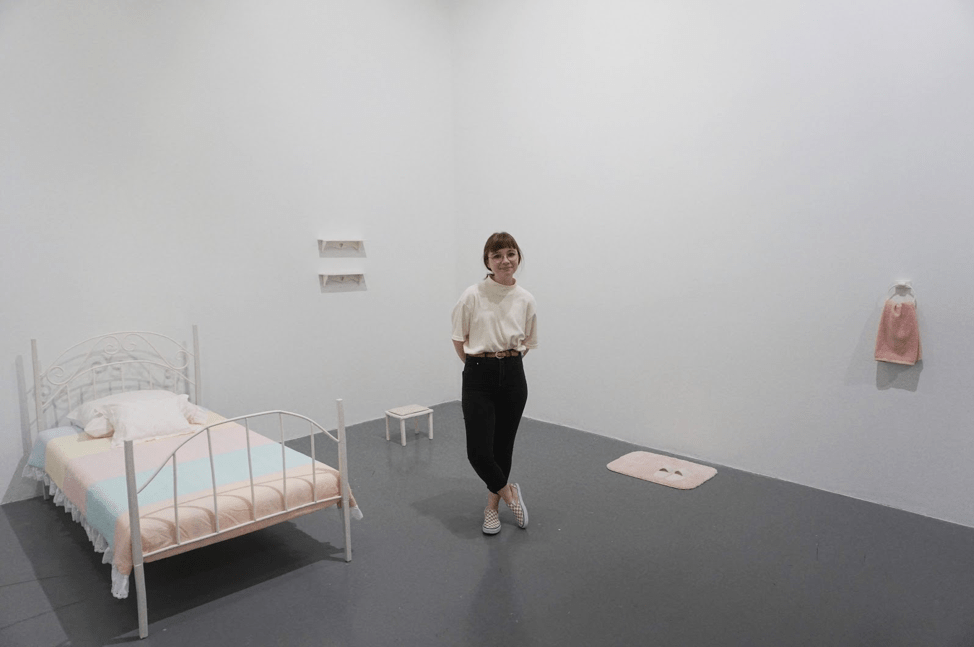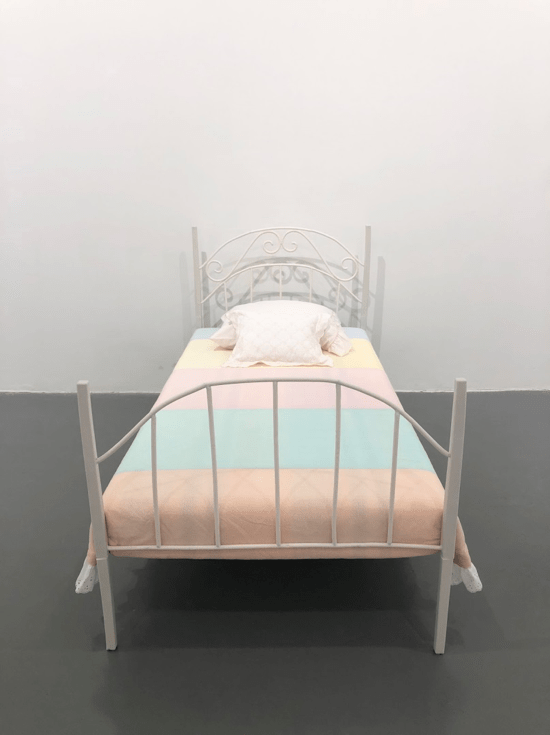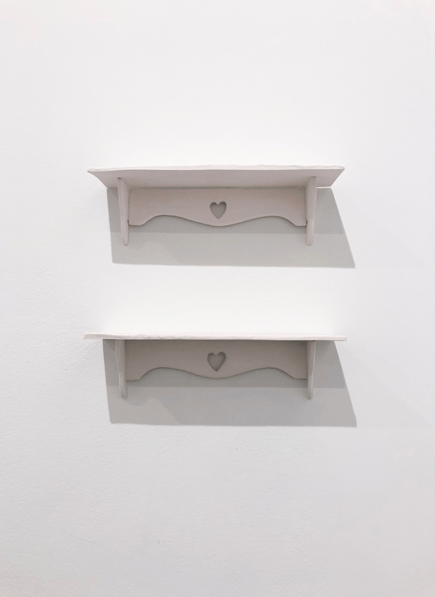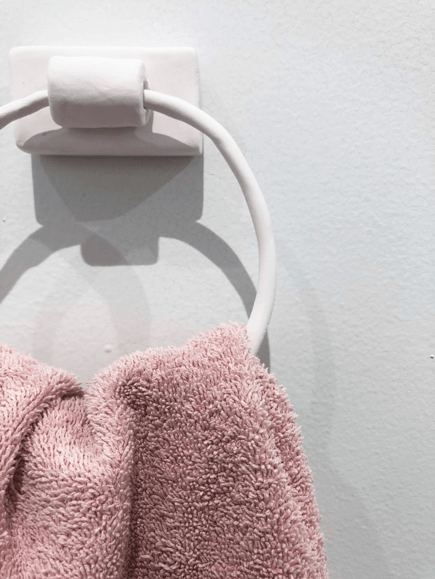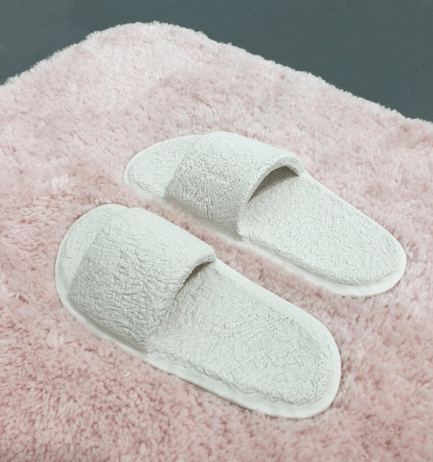HCCC curatorial intern Grace Winburne interviewed Texas ceramist and recent HCCC resident artist Audrey LeGalley about her creation of household objects in porcelain to address issues related to anxiety, fueled by domesticity. Audrey returns to HCCC to be part of Resident Artist Talks on Saturday, October 19, 2019.
Former HCCC resident artist Audrey LeGalley in her installation, “Girlhood Scary” (2019), featured in “Ghostly Demarcations” at Blue Star Contemporary. Photo courtesy of Barbara Miñarro.
Grace Winburne: Though your pieces deal with heavy subject matter, the porcelain that you use to create your installations is delicate and fragile. Why do you choose to work with porcelain, and how do you see the material relating to your subject matter as you address the theme of domesticity?
Audrey LeGalley: The visual weight of the material isn’t directly indicative of emotional weight in this work. The emotional aspects are explored through implied fragility and anxiety that is emphasized through delicate forms. I use porcelain in my work because most viewers understand an immediate reference to its break-ability, encouraging a sense of anxiety in the viewer. I also think it’s important that the material I use is found in domestic spaces—normally, porcelain has a place in the average American home. It’s used for tile and dinnerware. I’m taking the material out of its intended purpose in the home and using it in dangerous and impractical ways, to address themes of insecurity within the home.
Audrey LeGalley, “Bed,” 2019. Porcelain, silica, epoxy, found linens, foam mattress.Photo courtesy of Barbara Miñarro.
GW: Mental health issues can stem from one’s experiences, regardless of their home environment. How do you see a girl’s relationship with the objects in her home relating to issues that could be occurring internally? How do you see these thoughts and feelings reflected in the physical space a girl resides in?
AL: My work focuses more on the nurture portion of mental health and the role that family plays in that. I’m interested in how the unstable home environment can encourage and cultivate issues of anxiety in children. My installations are made up of porcelain, implying a sense of anxiety in the space–encouraging the viewer to imagine interacting with the fragile furniture and objects. Although the theoretical “girl” is interacting with these objects in an emotional capacity, I interpret the furniture to be more of a symbolically external force than internal. The objects reference sources of anxiety in the home space, such as other family members and circumstances. The work does, however, indirectly address internal susceptibility to mental illness, as this predisposition is part of the onset of mental health issues–even when encouraged by external factors. My installations are constructed with an intentionally sterile feeling that I think implies a coldness that gives a hint that something isn’t right or comfortable. Also nodding to early tendencies of orderliness in anxious children.
Audrey LeGalley, “Toy Shelves,” 2019. Porcelain, silica, epoxy. Photo courtesy of Barbara Miñarro.
GW: The objects you make represent different aspects of the home and growing up that focus on the emotional dimension of physical space. Your work stems from a childhood spent growing up in a pre-digital world. Nowadays, there is an aspect of one’s girlhood that lives online through social media and the way we communicate digitally. How do you see your representations of girlhood engaging with the Digital Age and the way our culture has shifted?
AL: I really like this question! Throughout this series, I have been focused on objects and spaces referential of my own girlhood—a time when the most advanced technology in the house was a first-generation ipod shuffle. While contemporary children still interact with furniture and domestic objects, they also gain much of their personal identity from the internet. Girls are starting to create Instagram accounts at age 10. I hardly have the emotional maturity at age 23 to handle Instagram’s effect on self-perception and worth. While in my work, I focus on familial relationships and settings that affect mental health, a future exploration of the role of technology with the young girl might be an interesting avenue. I’m not yet sure how that would materialize visually, as I generally work objects based, and these themes are slightly less tangible. However, there is definitely plenty of anxiety whirling around on the internet to explore.
Audrey LeGalley, “Hand Towel,” 2019. Porcelain and found towel. Photo courtesy of Barbara Miñarro.
Audrey LeGalley, “Slippers,” 2019. Porcelain and found rug. Photo courtesy of Barbara Miñarro.
GW: In mainstream culture, craft is often associated with functional objects. Your work challenges that, as the objects you make can’t serve the function that they appear to serve. What does disrupting the object’s function mean for you and your art?
AL: There is an expected functionality of clay, and I am making objects that traditionally do serve a physical purpose. This expectation can give the work more weight, I think. It really encourages the viewer to visualize themselves interacting with the space and objects as they would in their own home. This functionality allows the viewer to understand the material more intimately. Everyone knows what it’s like to hold a tea cup in their hand; they understand the fragility there. In removing the object from its functionality, it becomes a purely metaphorical object, a visual discussion of anxiety. Taking the traditional function away encourages thought and curiosity in regard to the work.
Installation view of “Girlhood Scary” (2019) at Houston Center for Contemporary Craft. Photo by Katy Anderson.
About Audrey LeGalley
Audrey LeGalley is a sculptural artist from San Antonio, Texas. Her work explores the relationship between the body and the home, focusing on girlhood and fragility through porcelain sculptures. Audrey graduated with her BFA in studio art from The Southwest School of Art in 2018 and begins her MFA in studio art at the University of Texas at San Antonio this fall. For more information, please visit www.audreylegalley.com.
